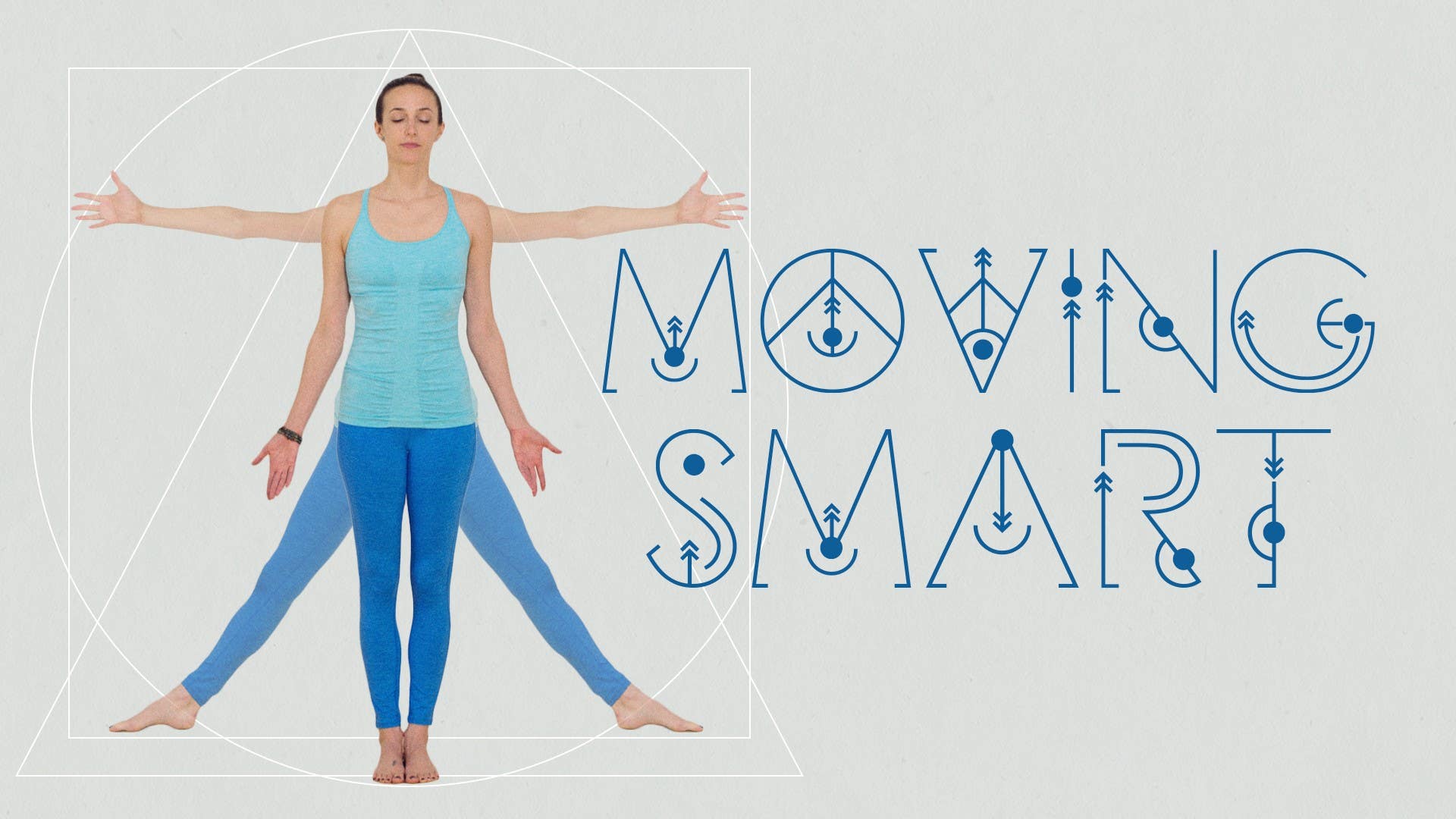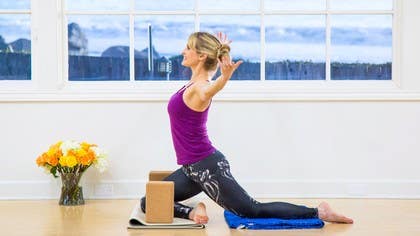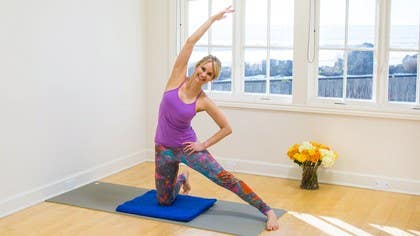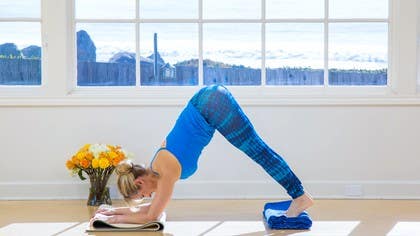Description
About This Video
Transcript
Read Full Transcript
Hi, welcome to my yoga deconstructed class. It's called Magic Blanket Ride, kind of like a magic carpet ride, but a magic blanket ride. And this practice will make you feel better from your head to your toes. We're going to start by strengthening your external rotator cuff muscles. You'll need a yoga strap and a block.
And I highly recommend a foam brick for this first exercise. The cork brick is doable, but it's challenging because it's heavy. I have my strap folded into a loop, and I created the loop in such a way that I can hold theâ??I'm wiggling around trying to get itâ??there we goâ??that I can hold the brick between my elbows and have some tension to pull apart on the strap. All right, here we go. So you're pulling apart on the strap, gripping the brick.
The brick might turn a little, mine might spin, and then you're going to lift your elbows up to the height of your shoulders. If you don't feel a little heat in your back pits, the back of your armpits, you might not be doing something correctly. But if you do, yeah, that's where we're going with this. I'm going to turn to the side just so you can see my alignment. So make sure that your pelvis isn't forward.
Make sure that you're not popping your ribs, so it's head, ribs, pelvis. And then you'll lift up and down. As you pull apart on the strap and hug the brick. And my god, my deltoids are on fire. Let's go for two more.
You lift up, lower down, last one, lifting up and lowering down. All right, so we're going to place the brick and the strap off to the side. And all you'll need for this next exercise is your blanket. And what you want to do with the blanket, I call this the Yoga Globe Trotter or the Yoga Sommelier because it makes me think of, you know, when you go to a fancy restaurant and the sommelier comes out and he or she usually has like a white tablecloth draped over their forearm and that tells you about the wine list. One other prop you'll want to grab, sorry, I forgot, is a brick.
And that's going to go between your upper inner thighs. And then we'll come into, we could call this like the double hitchhiking backwards pose. But I'm in external rotation and supination. And the blanket's just draped over my right forearm. Then from here, I'm going to internally rotate and pass off the blanket.
And then come into external rotation and pause. I'm going to turn to the side so you can see that when I pass it off, what I'm trying not to do is that, right? So you're using the internal rotators of your shoulders to transition the blanket from side to side. So each time you come into the sort of double hitchhiker, wind up elbows forward, hands back. Let's do that one more time, passing it off without rounding your spine, without your head going forward.
Oh, my arms are tired. I never thought a blanket could feel this heavy, but it does. All right. And then go ahead and just drop the blanket, close your eyes and feel. This sensation all around the shoulder girdle, as well as your connection to the brick between your thighs.
Feel your feet on the floor and then bring one hand to your chest, the other hand on top and just notice the pace of your heart and the pace of your breath. Go ahead and slowly open your eyes. And we're not going to need the blanket anymore, so go ahead and fold it up and just set it off to the side. We'll be using it again later. We will still use the block, so that's why it's still between my legs.
And I have a new strap, and the reason why is because it's a longer loop than what I used before. The length of the loop is such that you can place it kind of right at the center back part of your skull, and you can see how I have my elbows forward and my hands back. So what you don't want to do is this, that's kind of how you type on your computer and look at your keyboard, what you do want to do is this, this is external rotation. Then from here, just going to slide the strap along the back of your head from side to side. And I can feel the heat that I'm creating in the external rotator cuff muscles all through the shoulder girdle.
So just a few more of these, and then go ahead and pause, and remember again, don't let your pelvis go forward, try not to pop your ribs, you're in Tadasana. Your head is actually pressing back into the strap as you push the strap into your head. All right, let's take a little breather from that, and set the strap off to the side. As well as the block. Then we're going to use the same strap, but open it all the way up for what I call strap war.
And strap war is, it's more free flowing. So the idea is you're just holding the strap in two places, and you're moving it around in space, and you're pulling it apart. So oftentimes in yoga we get really stuck moving just in the sagittal plane, or just in the coronal plane, and we're not doing a whole lot of triplanar movement. This reminds me of one of my anatomy mentors, Gil Hedley, and he'll always say, you need to move. But anyways, it's a little bit of a fight with the strap, and then you can pick up the pace and engage, I know I'm making an ugly face, and really pull apart as though you're having a war with the strap, and you're exploring different levels.
So up high, out to the side, down low, again, jumping through, and notice what you do over and over again. So I kept going to the right, so I'm going to go to my left a little bit more, and hopefully you're feeling a little bit of heat, I know I am, so I just sweat. What are you doing with your spine? Are you continually rounding, are you continually arching, can you rotate? And then I'm a little exhausted, that means you're done.
Drop the strap, close your eyes, and observe. So there's what's called interoception, noticing what's going on on the inside of your body, the pace of your breath, pace of your heart, and then there's proprioception. So where's my body and space, where are my hands, even though I can't see them, where's my head, relative to my torso. And just vacillating your awareness from interoception to exteroception as you watch your pace, breath and heart slow back down. Go ahead and open your eyes, and we're going to make our way onto our belly so that we can check in with the elbows forward, hands back, prone, you'll get a little different feedback.
Grab your blanket and roll it up so that you have some cushion for underneath your forehead, and then kind of guesstimate, that's what I'm doing, where your loop was before so that you have the right amount of tension. So that's too narrow, go a little bit wider, and then let's see, perfect, all right, I'm going to try to get this tail out of the way so it doesn't fly everywhere, and we're ready to go. So coming onto your belly, forehead on the blanket, the strap is behind your head, and your elbows are on the floor, but my hands are off. So this is no work at all for my external rotators, and this is a lot of work. So I'm pressing into the ground with my elbows, and I'm lifting my hands up and pulling the strap apart.
Then from here, I'm also going to lift my head up. When you're in a plank, a down dog, four point kneeling, it's often a challenge where your head is in space, but the straps giving you feedback, it's helping you to strengthen the muscles along the back of your neck, but also the front of your neck. One more time, try to lift the hands up as you anchor the elbows down, and then rest. Go ahead and get rid of the strap, and let's try that open chain with hitchhiker thumbs. So make fists, thumbs up, elbows on the floor, take a breath in, and as you exhale, lifting your forearms off the ground, and then lower back down.
We'll do that two more times. Forearms, sorry, elbows into the floor, forearms off, and then you can hover your head for a moment. It feels really good through this upper thoracic to get the activation there. I'm anchoring down through my toes, and take a break, we'll go one more time. Take a breath in, exhale, forearms lift off, forehead lifts off, pause here and breathe, and you can even pull your chest slightly forward and up to get some upper thoracic extension.
And then rest, whew, okay, bring your hands under your shoulders to press yourself up, and all we'll need for this next exercise, I call it serving pizza, is a brick. So you can put your blanket aside, as well as your strap, and I'm going to use a cork brick for this, the weight of it makes it a little bit easier. You're trying to not grip it, you want to actually have it on the top of your hand, and I'll start with it on my left palms, just so you can see a little bit better what I'm doing. So let's come into three point kneeling. So I've got my right wrist under my right shoulder, knees under hips.
Here's external rotation. Let's start actually in internal rotation. And then lift the brick up as high as you can, head in line with your spine, whew, lots of work in the back of the shoulder, lots of work through the right shoulder, and then bend your elbow, and as you externally rotate, you'll bring your right foot forward, tuck the left toes, and come up, and then we're going to internally rotate and transition right back down, whew, into three point kneeling. And we'll do it again. Spin it around, right foot forward, left toes tuck, come on up to stand.
And then same thing, transitioning back, let's do left foot back, and then here's your 90 handy. Start to internally rotate, replace your hand where your foot was, and lift the block up as high as you can. All right, externally rotate, step forward, come up, and we'll switch sides. So block is in your right hand. This time I'm going to step back with the right foot.
We could step back with the left foot. I just did the same side foot as the hand in the block on the other side, so I'll try to stay consistent. So right foot steps back, internally rotate, and connect in your three point kneeling. Lift the block up, spin it around. I think it's right foot forward, I'm not sure.
As long as you're going from standing to what's called a 90-90, so this is a 90-90, you got 90 degrees at the ankle, knee, hip, same thing here. And you're going from internal to external rotation. You can play with whatever choreography works best for you. Lift the block up, spin it around, external rotation, transition, back up, you can even lift it up a little, just for a show off moment. And then why not, I'm going to step back with my left foot this time.
Left hand on the ground, internally rotate, and extend. All right, last time to come back up, external rotation, I'm doing left foot forward, whichever you like, come up to stand, lift up your brick, and we're going to recheck what we did at the very beginning of the practice. So prop wise, you'll keep a brick, but I recommend going back to the foam brick because it's lighter, and I have two shorter, or I have three loops here, but I'm going to go back to the shorter loop, and this is where we took the loop in the palms of our hands and bracketed the brick between the elbows. Here we go, you ready? The brick's going to spin a little bit, that's all right.
Put your elbows up to shoulder height, pull apart on the strap as you hug the brick, and then lifting up and down. And just to give you an idea from the side view, and the back view, so I'm trying to keep my head above my ribs, my ribs above my pelvis, so I always say don't put your pelvis on the shelf. And my goodness, it actually feels much easier this time around, hopefully it's the same for you. Okay, whew, making me hot and sweaty. All right, so we can put the props away, and just come to stand and feel, bringing your awareness to your shoulders, the tops of your shoulders, the backs of your shoulders, migrating your awareness all the way down your arms into your hands, and then feeling the floor with your feet.
Notice your poise, and if it's a little bit easier to just stand in a position where it doesn't feel like your shoulders are rounding forward, but you also don't need to squeeze them back. Go ahead and open your eyes, and we're going to come down to the ground. So these are kneeling forearm slides, and you'll need to fold your mat in half to get a little bit of extra padding underneath your knees. And then we're going to use the blanket for your forearms, and a block for in between your thighs. If you like a little bit of extra padding under your knees, you can fold it one more time, which I'm going to do.
Yeah, and that feels much nicer. And then the block can go the narrow width or the wider width, I'm going to go with the narrower width. And coming down onto your forearms, we're going to flip our palms up, because again, we're going for external rotation. And let's just play here with sliding straight out. And really, you just go as far out as you know that you can come back in.
So I also teach Pilates, and much of my inspiration for what I teach in yoga comes from the work that we do on the Pilates apparatus. So this would be something that you could do on the Reformer, and I highly recommend cross training with Pilates. Wow. For your yoga practice. All right.
Let's play with going to the side. So I'm going to steer over to the left, and angle out to the side, and then come back in. Let's play with a little bit of cat-cat. So I'm going to round my spine as I slide out, and then arch to come back in, swing around. I'll go neutral to start.
And then repeat. Cat pose, spinal flexion, on the way out, and then cow arch on the way back, coming back to center. Let's flip it. Let's arch on the way out, and around, on the way in. And then slowly coming back up, pause for a moment.
You can have your toes tucked under or tops of the feet on the mat. And again, bring one hand to your heart, and the other hand on top. Embracing your heart's pace, and your breath's pace. Go ahead and open your eyes. And we're going to put the props away just for the moment, so you can slide your blanket off to the side, place the block off to the side, and return the mat back to the way we had it before.
For our speed skater lunges, you'll want to grab a brick. I'm grabbing the heavier cork brick because we're going to balance it on our sacrum, and heavier is just a little bit easier. So separate your feet wider than your hips, take your brick, and place it on your sacrum with your knees bent. And then bring your hands to the ground. And from here, think of your conveyor belts at the airport, and the block is the luggage.
And for some reason, the conveyor belt just gets stuck and keeps going side to side. And you can see I'm going slow because I'm trying not to lose the brick. But there's this action, actually, a pushing from the outsides of your legs. You can even touch the outsides of your legs just to give you some kinesthetic feedback. But you could also think of propelling from side to side using the insides of your legs.
And again, here I'm touching the insides of my legs just to get a sense of that's where the motion is coming from. Then pause for a moment and take a little breather because that's intense. And then we're going to take the brick to the mid-back. So I call it the bra strap or the bro strap. So a little bit higher up because sometimes you're able to sense where your sacrum is because there's a block there, but you're sort of dumping in the ribs.
So you want to feel that the brick is at your mid-back, and then it's the same thing. It's like there's a table from your head to your tail. And you know, appetizer goes here, the block's the main course, the dessert plate was on your sacrum. Now it's gone. You ate dessert first.
Otherwise, this is the same. And you can get a little bit lower, make it a little more dynamic. And then coming center, come back up, get rid of the brick for a moment, and hang in ragdoll. From here, go ahead and toe-heel your feet back so that they're underneath your sitz bones. Shake your head, yes and no, and then just shake your arms as you roll up to stand.
Okay, we're going to make our way into swimming cobras and twisted cobras. What you want to do first is we don't need the brick, so you can place it off to the side for now, and then fold your mat in half. And you want to grab your blanket, and this is the water. We're going to go for a swim, cobras that swim. Snake swim, right?
And to start, open it all the way up so that you have the fringe on either end, so that you can start to scrunch the blanket up and have all the material wrinkled in the middle. Then coming onto your belly, have your pelvis, so your hip bones and your pubic bone, on the mat, so you have a little cushion, and we'll come into Sphinx Pose. Sphinx Pose is elbows under shoulders, forearms parallel. Because we're still continuing with this theme of external rotation, do thumbs up or even better, full supination and external rotation. From here, let's take a dive into the water.
So dive into the ocean, we've got one right nearby, and then open your arms, arch to come up, and then gather up the fabric as you dive back into the water. Spread your wings, thumbs out, external rotators working, and taking a dive. Let's do a few more, but increasing the pace, and you can go as high up as you want. So make this back bend your own. Then we're going to reverse.
So come through the center line, open your arms out, and then dive forward. Gather up the blanket, pull it into your heart, spread it out, and slide out. One more time. Hug in as you lift up, open out, dive forward, and then rest. Let's do one more variation of the swimming cobras.
I call this the twisted cobras. So gather up the material of your blanket, coming back into sphinx pose. For this one, have your palms facing down, and it's kind of like a little game of peek-a-boo. So what I'm going to do is take my right elbow out to the side and up, kind of like a weird chicken wing push-up, as well as the left arm, and then I thread the needle, push into the ground. So there's a lot of pushing action to spin, twist, and peek under the right.
And then again, I push down into the ground. This is inspired by work on the gyrotonic handle units, which is one of my favorites. And I love to bring some triplanar three-dimensional movement into our yoga practice that can sometimes get a little bit linear. That's fine, spin around, rotate your rib cage, thread the needle, and then resist into the floor, come back to your sphinx, and rest in cobra, or crocodile, sorry. Okay, from here we're going to fold up the blanket for our very last sequence.
So this is the magic blanket ride. And the blanket is actually going to go underneath our feet. And the mat is going to go underneath your forearms. So I'm going to fold the mat in fourths, and we'll see what happens, because we're going to start, believe it or not, in sphinx again. Okay, so once you're in sphinx pose, elbows are under your shoulders, forearms are parallel.
You're welcome to do palms down or palms up. We're going to start by dropping the crown of your head, protract into pressure shoulder blades. So push down around your spine and lift your pelvis and thighs off the ground. Tuck your toes. And then from here, lift your forearm plank, slide the blanket towards you, and then slide back out to your forearm plank, and lower back down.
So that's part one, we'll do that again. So palms up or palms down, start by flexing your spine. So crown of the head drops, you'll puff up between the shoulder blades, and you can come into this full top of the foot, forearm plank, it's really hard if you can tell I'm barely talking and breathing, tuck the toes, and then the same thing, slide it forward, slide it back, and lower back down. Definitely more challenging. Okay, here's part three, I'm going to do palms face down and toes tucked under.
Take a breath in and start to come into cat, so to speak. So rounding your spine, floating the chest, the belly, the hips, the thighs, the knees. Slide it in, and you're in turbo dog or dolphin, you'll come to your downward dog, and then lower back to your dolphin or your turbo dog, whichever your preferred name is. Come to your forearm plank, and then lower back down. Let's do one more time just because it's fun.
Tuck the toes under, take a breath in, exhale, start by rounding your spine. Knees lift, slide the blanket forward. You don't have to lift your forearms and elbows up, it's optional, lower them down, slide back out, and lower back down. Take a little breather here, because that was intense, and notice your breath. Okay, coming on up, my mat is already set up like so, so you can set your mat up as well, and then grab a yoga brick, and come to lie on your back.
You want to lie on your back first before you put the brick underneath your sacrum. The brick can go either at the first level, the second level, I wouldn't do the third level. So I'm going to go on the first level just today, but choose which makes the most sense for you, and then just pause for a moment with your palms facing the ceiling, and close your eyes. And feel the support of the floor, and the support of the brick. Then slide your left leg out long on the mat, and interlace your fingers either below your right knee, on your shin, or behind the thigh, whichever feels better for you.
I'm wiggling a little bit to find the right spot. And from here, go ahead and pull your knee toward your chest, that might make the left leg float up a little bit. And if it did, drop your leg down so that there is a connection between your heel and the floor. And then just pausing here, and noticing your breath. What tends to happen is sometimes a little bit of hip hiking, so try to find some equal length through both sides of your waist.
And then release the grip, right foot to the floor, left foot to the floor, wiggle around a little, make sure you like where the brick is, straighten your right leg, and then pull your left knee to your chest. And then inhale, you can do as you like with your feet, so if you want to dorsiflex and make it a little more active, try that, but you can also try more floppy feet, and see which one you prefer. And then inhale, wave your breath from your belly to your heart to your throat, and then exhale. Let's do that one more time. Feeling the belly swells, the ribs expand, filling up your lungs, and then exhale.
Slowly release, find the floor with your feet, and then lift your hips up, remove the brick, lowering your pelvis back down. And then coming into shavasana, so you might want to do a traditional shavasana, or if you prefer, knees bent, feet on the floor. Just find any position that you can relax into. And then close your eyes, and soften, allowing your eyelids to be very heavy. So heavy that they feel like dark black velvet drapes.
And the soft pile of the velvet massages your eyeballs, so that your eyeballs can sink backwards into the center of your skull, melting into the floor as you relax your brain. Raw softens, as well as all your facial muscles, neck, and shoulders. Feel the back of your heart sink towards the floor. If you have more time, please stay here for as long as you like. If you need to move into the next part of your day, start by blinking your eyes open, sliding your arms overhead, reaching your shoulders up to your ears, fingertips to the back of the room, toes to the front of the room, inhale, and then let it go.
Bending your left knee, finding the floor. Right knee bends, finding the floor with your foot. And then hug your knees in towards your chest, and rock a little. Massage your spine on the floor. Go ahead and roll over onto your right side, and pause.
Go ahead and press your left hand into the floor, and then start to make your way up to a comfortable seated position. Connect your palms together at your heart center, lengthen through your spine, bowing head to heart. Thank you all for practicing with me today, namaste.
Moving Smart: Trina Altman
Comments
 I’m so glad you are enjoying these classes! Thanks so much for taking the time to say hi here Rose. I hope I get to come back and teach in Cork again someday !
I’m so glad you are enjoying these classes! Thanks so much for taking the time to say hi here Rose. I hope I get to come back and teach in Cork again someday !
You need to be a subscriber to post a comment.
Please Log In or Create an Account to start your free trial.













